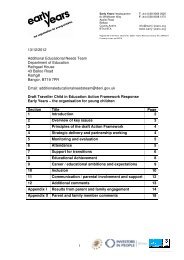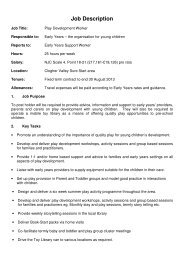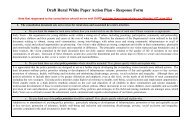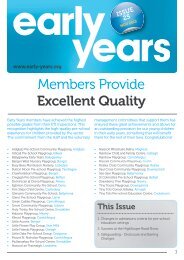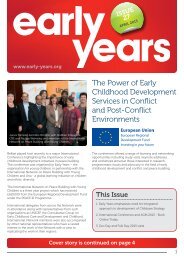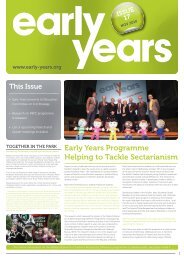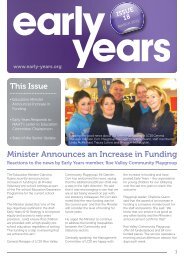Learning from Nine Examples of Peacebuilding Evaluation
Learning from Nine Examples of Peacebuilding Evaluation
Learning from Nine Examples of Peacebuilding Evaluation
You also want an ePaper? Increase the reach of your titles
YUMPU automatically turns print PDFs into web optimized ePapers that Google loves.
Panelists and audience members at the Summit included representatives<br />
<strong>from</strong> the US Agency for International Development, the US State<br />
Department, the World Bank, the United Nations, the International Development<br />
Research Centre, and other major nongovernmental organizations<br />
(NGOs), foundations, and evaluation consultancies. In addition to US, Canadian,<br />
and European participants, participants <strong>from</strong> Kenya, Israel, Ireland,<br />
Iraq, Thailand, and the Philippines attended.<br />
Prior to the Summit, a review committee selected nine organizations, out <strong>of</strong><br />
nearly thirty that responded to a call for submissions, to present evaluations<br />
to an audience <strong>of</strong> donors, evaluation experts, and practitioners. Presentations<br />
were made by:<br />
1. Global Partnership for the Prevention <strong>of</strong> Armed Conflict (GPPAC)<br />
2. CDA Collaborative <strong>Learning</strong> Projects and Human Systems Dynamics<br />
Associates<br />
3. Search for Common Ground<br />
4. Early Years—the organization for young children<br />
5. Friends <strong>of</strong> the Earth Middle East<br />
6. Mercy Corps<br />
7. Building Markets (formerly Peace Dividend Trust) 1<br />
8. Brandeis University, Acting Together<br />
9. Pact, Kenya and Act!<br />
Each presentation was followed by focused and structured feedback <strong>from</strong><br />
a panel <strong>of</strong> commenters that included donors, practitioners, and evaluation<br />
experts and a broader conversation with Summit attendees. The challenges<br />
and tensions surrounding evaluation were not resolved at the Summit, but<br />
the rigorous discussion led to some consensus on both helpful and problematic<br />
dynamics as well as possible solutions to maximize the effectiveness<br />
<strong>of</strong> evaluations under a range <strong>of</strong> real-world constraints. By presenting and<br />
critiquing these nine cases, the Summit provided tangible examples <strong>of</strong> effective<br />
peacebuilding evaluation as well as insight on how evaluation can be<br />
improved further.<br />
7<br />
The Evidence Summit illustrates a trend away <strong>from</strong> talking about the challenges<br />
<strong>of</strong> peacebuilding evaluation and what might be possible toward talking<br />
about what is being done and how tensions between ideal and feasible<br />
evaluation practices can be resolved. To accelerate this trend, which we consider<br />
a healthy one, this report summarizes major themes and key findings<br />
<strong>of</strong> the first Evidence Summit, presents the nine evaluation presentations in<br />
the form <strong>of</strong> case studies, and provides guidance for practitioners on holding<br />
additional Evidence Summits.<br />
1 At the time <strong>of</strong> the Summit, the organization was called Peace Dividend Trust. In this report, we use their new<br />
name: Building Markets.



